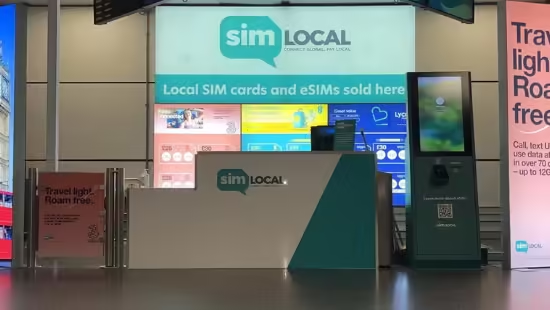
American Travel Trends: Beaches, Budgets & Bucket Lists
As the sun sets in the summer of 2024, millions of Americans are already turning their sights towards the next adventure. With the echoes of beach days and road trips fading, many are eager to plan their next getaways. In fact, as early as the beginning of the year, Blueprint partnered with Talker Research to survey 1,000 Americans about their travel aspirations for the coming months. American Travel Trends 2024
Not only did Blueprint uncover the most popular travel destinations (beaches rule, no surprise there), but they also gained insights into the way Americans are planning their getaways, the type of accommodations they’re most interested in, and how they’re going to get there. You’ll also learn about Americans’ biggest travel fears and have some tips to avoid the most dreaded vacation disasters.
Read on to learn more about this year’s travel trends, along with tips on how to plan and pay for your next vacation.
Key Findings American Travel Trends 2024
- Americans take 2.5 vacations per year.
- The average vacation in America costs $1,742.90.
- 30% of Americans plan to travel internationally in 2024.
- Beaches top the list of desired trips, with 62% of Americans saying they target beaches when planning vacations.
- To help defray the expense, 53% of Americans have used or plan to use their rewards from credit card rewards or travel loyalty programs to reduce their out-of-pocket costs for airfare and hotel expenses.

Expensive vacations don’t deter American travelers
There’s no such thing as a cheap vacation for most Americans. The average traveler spends $1,742.90 per vacation. Still, nearly half of respondents said they spend less than $1,500 on their trips, while 1 in 10 said they spend more than $3,500.
The sweet spot for more than half of Americans is one to two times per year, while almost a third getaway three to four times. One in 10 Americans leave town up to six times a year.
Almost two-thirds of Americans want to hit the beach
Most Americans love to spend their vacation time doing outdoorsy and cultural things, but nothing beats sun and sand. The most popular destination by far was the beach, with almost two-thirds (62%) of survey respondents naming it a preferred destination. Luckily, there is no lack of options when it comes to catching some waves and rays, with over 6,100 beaches along U.S. coasts.
Cities and cultural or historical locations were tied for second place, with 44% of respondents listing one of these among their preferred destinations. Visiting one of America’s 63 officially recognized national parks was just the ticket for 42% of respondents, while 40% said they wanted to see mountains.
Over a third (39%) of survey respondents have their sights set on famous landmarks, such as Mount Rushmore, the Statue of Liberty or the National Mall in D.C. Ultimate relaxation is on the horizon for the 30% of people looking to go on cruises this year and 29% who want the effortless luxury of an all-inclusive resort.
With so many destinations across the country high on people’s agenda this year, it’s surprising that three in 10 travelers also plan to leave the U.S. and travel internationally in 2024.
Travelers prefer hotels over private rentals
As for where Americans like to rest after their daily vacation adventures, home is where the room service is. Hotels, condos and resorts are a favorite among 78% of travelers who would choose them as a preferred lodging. Not only is there no bed-making or towel-washing required, but the average daily rate of staying in a hotel is still reasonable at $151.13, according to the most recent data from STR, a real estate data research and analytics company.
For travelers who like to vacation like a local or for larger groups that would find booking multiple hotel rooms uneconomical, renting a private property can be a better choice. There is no shortage of rental home options in the U.S. for the 44% of respondents who cited renting a homeshare or house as a regular choice. There were over 2.4 million vacation rental listings in 2023 with an overall daily rate of $308 according to data from AirDNA. American Travel Trends 2024
Of course, rather than paying for a place to rest your head, staying with family and friends is another option while traveling and a great way to save a few bucks. Forty-one percent of travelers listed this as one of their preferred accommodations.
Camping and staying in hostels were less popular choices: 22% of survey respondents are prepared to pitch a tent on vacation, while just 11% of respondents would opt for a hostel. Few Americans are interested in leaving their house to take care of someone else’s, with house sitting only a preferred accommodation for 5% of people surveyed.
Americans’ biggest travel fear is the weather
Vacation planning is not without worry. With so much time and money invested to make every trip magical and Instagram-worthy, it’s only natural to have a few travel fears. Americans’ biggest travel fear is the weather, with 58% of respondents worried about inclement weather interrupting or ruining travel plans. Given that so many vacation activities are related to being outside, it’s a legit concern.
The second biggest concern is getting sick (44%) followed by fear of disappointment in the destination itself (30%). Many travelers are also worried about safety, including crime rates in the destination (28%), getting scammed (26%) and getting robbed (25%).
The remaining fears are things that can be mitigated by taking advantage of travel protections offered by some travel credit cards and travel insurance. These include losing luggage (28%) — some credit cards will reimburse you for lost luggage or even baggage delays. Another is being late or missing travel accommodations (26%) — trip interruption insurance is another coverage that some credit cards offer.
Planes, trains, or automobiles?
Most Americans like to go wheels up for their trips, with 47% choosing travel by plane as their preferred transportation method. According to the Bureau of Transportation, the average fare for a domestic flight in the U.S. (as of Q4 2023) was $384.85. This means that airfare alone can take up a good portion of a vacation budget.
As such, it’s no surprise that road trips — or travel by car — were nearly as popular, chosen by 44% of respondents. Even with average gas prices at $3.60 per gallon (as of May 2024), piling into the family car can be a cost-effective way to get to your destination.
Train travel was a distant third, with just 3% of people reporting they prefer to travel by rail.
Vacation planning habits revealed
One-third of Americans take nearly three weeks (2.9) to plan their trips, with about one-fifth booking almost five weeks (4.9) in advance. As part of their research in deciding where to go and what to do, 43% of people lean heavily on recommendations from friends and family.
A significant number of trip planners (32%) rely on online reviews, while fewer than 1 in 5 (19%) use a travel agent. Social media is also a source of travel inspiration with respondents turning to YouTube (17%), Instagram (9%), Facebook groups (8%) and TikTok (6%). Reading travel advice from travel blogs (15%), articles (13%) and magazines (10%) is also a significant part of the planning process.
As for what people consider the most important factors when planning a trip, 55% of people selected local food and drinks, while 54% valued the best financial deal. Outdoor activities (46%) and cultural experiences (39%) were also high-ranking choices, while 35% of respondents built their trips around bucket list locations.
Solo travel vs. group travel
The majority of Americans prefer to travel for leisure with their significant other (41%) or immediate family (28%). But traveling solo is a preference for 15% of respondents.
Group travel is less popular, with just 10% of Americans saying they prefer travel with a small group.
People who travel solo generally spend less time planning than those with travel companions (2.6 weeks vs. 2.9 weeks). They also book their trip an average of 4 weeks before compared to 5.1 weeks for couple/family travelers.
Preferred travel accommodations vary between solo and group travelers as well, with single people more likely to stay with family or friends:
Who Americans travel with affects more than just where they stay — it also influences how they get there. Single travelers are less inclined to drive by themselves, whereas going by car is often a money-saving option for groups.
Not surprisingly, solo travelers spend less per trip, though not that much less: $1,433.30 on average vs. $1,843.90 spent by couples and families.
How Americans use their travel rewards credit cards while traveling American Travel Trends 2024
Considering that 54% of travelers said finding the best financial deal has the biggest impact on their travel plans, using travel rewards credit cards strategically can play a big role. Leveraging the best travel credit cards can enhance the way you travel, provide insurance and protection, and help you save on the total cost of your trip. In fact, 53% of people said they have used or plan to use a credit card or travel rewards to reduce the cost of their trips.
Bolstering these findings, the Barclays 2024 Travel Rewards and Loyalty Report, which features data from a survey of 1,000 U.S. adult travelers by Wakefield Research, found that rewards programs will make all the difference when it comes to planning personal travel. The report found that personal travel is top of mind for many consumers this year and rewards programs will make all the difference.
“For the second year in a row, we found that U.S. travelers continue to highly value rewards points and loyalty programs,” said Doug Villone, head of cards and partnerships at Barclays US Consumer Bank. “Without rewards, 77% of travelers indicated they would have to make some sacrifices in how they travel. Many said they would need to give up comfort, as a third (33%) would have to downgrade their accommodations, and 28% would have to drive or take less convenient travel options.”
However, just 32% of Americans actually have a travel credit card as of the USA TODAY Blueprint-Talker Research survey date. Interestingly, men are significantly more likely to have a travel rewards card (39%) than women (25%). Men are also more likely to redeem travel rewards to defray the cost of travel (59%) than women (47%). American Travel Trends 2024
Maximizing Your Credit Card for Your Next Trip
Unlocking the Power of Travel Rewards
As you embark on your next adventure, consider the strategic use of travel rewards credit cards to enhance your experience and potentially save money. Here are some tips to maximize your rewards:
1. Welcome Offers: A Rewards Boost
Start your journey with a welcome offer. Many travel credit cards offer substantial bonuses upon opening an account. These points or miles can be redeemed for flights, hotels, or other travel expenses, providing a significant head start on your rewards balance.
2. Tailoring Your Card to Your Spending Habits
Choose a card that aligns with your spending patterns. If you frequently dine out, a card with elevated rewards for dining could be ideal. For those who prioritize travel, a card with travel-focused rewards might be more beneficial. Consider your spending habits and select a card that maximizes your rewards potential.
3. Responsible Spending: The Key to Rewards
Avoid overspending to earn rewards. The true value of rewards cards lies in paying off your balance in full each month. Carrying a balance can negate your rewards by accruing interest, ultimately diminishing the benefits.
4. Premium Travel Cards: Weighing the Costs and Benefits
If you're a frequent traveler with good credit, a premium travel card might be worth considering. These cards often offer higher rewards and additional benefits, such as lounge access, priority boarding, and travel insurance. However, they typically come with an annual fee. Carefully evaluate the costs and benefits to determine if a premium card aligns with your travel needs and financial goals.
5. Airline and Hotel Cards: Loyalty Pays Off
If you're loyal to a specific airline or hotel chain, consider a cobranded card. These cards offer points or miles tied to the loyalty program, along with exclusive perks like free checked bags, priority boarding, and room upgrades. However, if you prefer flexibility in redemption options, a general rewards card might be a better fit.
6. Avoiding Foreign Transaction Fees
When traveling abroad, be mindful of foreign transaction fees. Opt for credit cards that do not charge these fees to avoid additional costs and maximize your rewards.
7. Understanding Card Benefits: Beyond Rewards
Many travel credit cards offer valuable protections beyond rewards. These can include trip cancellation/interruption insurance, lost baggage coverage, and travel accident insurance. These benefits can provide peace of mind and potentially save you money in unforeseen circumstances. Additionally, some cards offer fee credits for TSA PreCheck and Global Entry, streamlining your airport experience. American Travel Trends 2024
Conclusion American Travel Trends 2024
As the summer of 2024 draws to a close, the travel industry remains vibrant and full of promise. Americans continue to prioritize travel experiences, seeking adventure, relaxation, and cultural enrichment. By understanding the trends and leveraging tools like travel rewards credit cards, travelers can make the most of their getaways, creating lasting memories and maximizing their vacation investments.
The future of travel looks bright, and with careful planning and a strategic approach, Americans can embark on unforgettable adventures that enrich their lives and expand their horizons.











